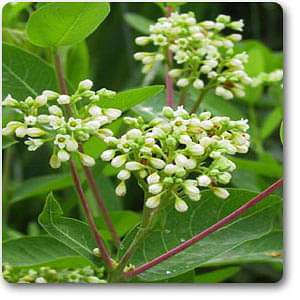Description
Apocynum cannabinum is a bushy member of the dogbane and milkweed family.
This herbaceous perennial plant becomes about 2 ,5 tall at maturity. Initially, this plant develops an erect central stem with opposite leaves during the late spring, but during early to mid-summer it branches abundantly. The stems are light green to red, terete, glabrous, and sometimes glaucous.
At intervals along these stems, there are pairs of opposite leaves.Plant Specifications
| Common Name | Dogbane, Amy Root, Hemp Dogbane, Prairie Dogbane, Indian Hemp, Rheumatism Root, or Wild Cotton, Indianhemp |
| Maximum Reachable Height | 2.00 to 4.00 feet |
| Flower Colour | Individual flowers have 5 white or greenish-white petals. |
| Bloom Time | July to August |
| Difficulty Level | easy to grow |
Planting and care
Apocynum cannabinum care
Cannas can be planted outdoors in warm climates or containers in other areas. During spring, when planting of canna lily plant, wait until the threat of frost has passed. Groups of cannas should be planted about a foot or two apart.
| Sunlight | Full sun |
| Watering | Dry to medium |
| Soil | well-drained soil |
| Fertilizer | Apply for organic fertilizer |
Apocynum cannabinum special feature
After the latex has been squeezed from the plant, it is allowed to stand overnight to harden into a white gum which can be used (sometimes mixed with clean clay) as chewing gum.
Apocynum cannabinum uses
Ornamental Use:
- A good plant to naturalize in a butterfly garden, native plant garden or wild garden
Medicinal Use:
- It is also used in herbal medicine to treat fever, dysentery
Culinary Use:
- The seeds have an edible use as a meal (raw or cooked) when ground into a powder



Comment